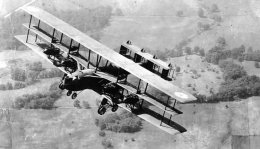Post by David E. PowellOuch. Sometimes replacement materials don't work too well, it is a
shame that this went through, I wonder if they asked the math types
what would happen if they switched the materials?
Miss Chitty knew; here's her quote from Bill Gunston's "Giant Of The
Sky" book; "Mr. Tarrant was an inspired timber merchant who dreamed of a
super-Camel. It hadn't a chance. It was too big, too heavy - that wasn't
its fault, but Grade A spruce had by now run out and and it had to be
built of American white wood (tulip). In my language 3,500 instead of
5,500 lb/sq in." I assume she's referring to its structural strength,
and the tulip is only around 2/3rds as strong as the spruce.
I suspect even if they had made it out of spruce it would not had much
better performance than the very similar Barling.
About the only country that had any real luck with really giant bombers
in that period was Germany with their "R" series aircraft.
Here's a real oddity... the Linke-Hoffman R.II:
Loading Image...
"What's so odd about that?" you ask, "It's just a single-seat light bomber."
Actually, that's what happens when you take a single-seater light bomber
and scale it up to huge size; the prop on that monster is powered by
four 260 HP engines mounted inside the fuselage, and the prop itself has
a span, tip-to-tip, of 23 feet. The aircraft itself has a span of 138
feet, and tips the scale at over 33,000 lbs fully loaded.
The picture is from this page:
http://www.bravenewworld.demon.co.uk/lists/germangiants/index.htm
Pat
